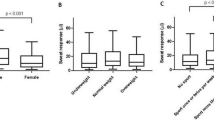Abstract
Objective
To investigate the risk factors for pilonidal sinus in teenagers.
Methods
Between January 2013 and September 2015, 55 teenage patients who underwent surgery due to pilonidal sinus disease (PSD) in the Department of Pediatric Surgery, Sakarya University Teaching and Research Hospital were included in this study. Age, gender, body mass index (BMI), number of baths taken per week, time spent sitting per day, family history, and skin color were examined as risk factors. The control group comprised of healthy teenagers without pilonidal sinus disease.
Results
Out of the total 42 teenagers, 23 (54.8 %) were girls and 19 (45.2 %) were boys. Patients were classified as obese, overweight, or normal according to their BMI (14.3 %, 31 %, and 54.8 %, respectively). The number of baths taken per week in the PSD group was lower than that in the control group [odds ratio (OR): 3.690; p = 0.004]. The family history of PSD was significantly higher in teenagers with PSD, compared to the control group (OR: 8.652; p = 0.005). No differences were detected between the PSD and control groups with respect to sitting for ≥ 6 h per day (OR: 3.212; p = 0.028). Skin color was not found to be affected by PSD in teenagers (OR: 1.294; p = 0.392).
Conclusions
Heredity and the number of baths taken per week were found to significantly affect the incidence of PSD, whereas other variables (gender, age, BMI, skin color, and time spent sitting per day) did not exhibit any significant influence on the rate of incidence.
Similar content being viewed by others
References
Hull TL, Wu J. Pilonidal disease. Surg Clin North Am. 2002;82:1169–85.
Yildiz T, Ilce Z, Kücük A. Modified Limberg flap technique in the treatment of pilonidal sinus disease in teenagers. J Pediatr Surg. 2014;49:1610–3.
Arda İS, Güney LH, Sevmiş Ş, Hiçsönmez A. High body mass index as a possible risk factor for pilonidal sinus disease in adolescents. World J Surg. 2005;29:469–71.
Nasr A, Sigmund HE. A pediatric surgeon’s 35-year experience with pilonidal disease in a Canadian children’s hospital. Can J Surg. 2011;54:39–42.
Yücesan S, Dindar H, Olcay I, et al. Prevalence of congenital abnormalities in Turkish school children. Eur J Epidemiol. 1993;9:373–80.
Lee SL, Talar T, Maher AA. Current management of adolescent pilonidal disease. J Pediatr Surg. 2008;43:1124–7.
Arda IS. Pilonidal sinus disease in children. J Pediatr Surg. 2008;43:1950.
Bütter A, Emran M, Al-Jazaeri A, Ouimet A. Vacuum-assisted closure for wound management in the pediatric population. J Pediatr Surg. 2006;41:940–2.
Yamout SZ, Caty MG, Lee YH, Lau ST, Escobar MA, Glick PL. Early experience with the use of rhomboid excision and Limberg flap in 16 adolescents with pilonidal disease. J Pediatr Surg. 2009;44:1586–90.
Bolandparvaz S, Dizaj PM, Salahi R, et al. Evaluation of the risk factors of pilonidal sinus: a single center experience. Turk J Gastroenterol. 2012;23:535–7.
Harlak A, Mentes O, Kilic S, Coskun K, Duman K, Yilmaz F. Sacrococcygeal pilonidal disease: analysis of previously proposed risk factors. Clinics (Sao Paulo). 2010;65:125–31.
De Onis M, Lobstein T. Defining obesity risk status in the general childhood population: which cut-offs should we use? Int J Pediatr Obes. 2010;5:458–60.
Fitzpatrick TB. The validity and practicality of sun-reactive skin types I through VI. Arch Dermatol. 1988;124:869–71.
Joshi SS, Boone SL, Alam M, et al. Effectiveness, safety, and effect on quality of life of topical salicylic acid peels for treatment of postinflammatory hyperpigmentation in dark skin. Dermatol Surg. 2009;35:638–44.
Aysan E, Ilhan M, Bektas H, et al. Prevalence of sacrococcygeal pilonidal sinus as a silent disease. Surg Today. 2013;43:1286–9.
Kaymakcioglu N, Yagci G, Simsek A, et al. Treatment of pilonidal sinus by phenol application and factors affecting the recurrence. Tech Coloproctol. 2005;9:21–4.
Afşarlar ÇE, Yılmaz E, Karaman A, et al. Treatment of adolescent pilonidal disease with a new modification to the Limberg flap: symmetrically rotated rhomboid excision and lateralization of the Limberg flap technique. J Pediatr Surg. 2013;48:1744–9.
Fike FB, Mortellaro VE, Juang D, Ostlie DJ, St Peter SD. Experience with pilonidal disease in children. J Surg Res. 2011;170:165–8.
Solla JA, Rothenberger DA. Chronic pilonidal disease: an assement of 150 cases. Dis Colon Rectum. 1990;33:758–61.
Sakr MF, Elserafy ME, Hamed HM, Ramadan MA, Kantoush HE, El-Torky HM. Management of 634 consecutive patients with chronic pilonidal sinus: a nine-year experience of a single institute. Surg Sci. 2012;3:145–54.
Karydakis GE. Easy and successful treatment of pilonidal sinus after explanation of its causative process. Aust N Z J Surg. 1992;62:385–9.
Bleich SN, Segal J, Wu Y, Wilson R, Wang Y. Systematic review of community-based childhood obesity prevention studies. Pediatrics. 2013;132:e201–10.
Kaplowitz PB. Link between body fat and the timing of puberty. Pediatrics. 2008;121:S208–17.
Doll D, Matevossian E, Wietelmann K, Evers T, Kriner M, Petersen S. Family history of pilonidal sinus predisposes to earlier onset of disease and a 50 % long-term recurrence rate. Dis Colon Rectum. 2009;52:1610–5.
Fitzpatrick EB, Chesley PM, Oguntoye MO, Maykel JA, Johnson EK, Steele SR. Pilonidal disease in a military population: how far have we really come? Am J Surg. 2014;207:907–14.
Kooistra HP. Pilonidal sinuses. Review of the literature and report of three hundred and fifty cases. Am J Surg. 1942;55:3–17.
Akıncı ÖF, Bozer M, Uzunköy A, Düzgün SA, Coşkun A. Incidence and aetiological factors in pilonidal sinus among Turkish soldiers. Eur J Surg. 1999;165:339–42.
Contributions
TY: Conceived, designed and did statistical analysis and editing of the manuscript; BE, AY and HTT: Data collection and manuscript writing; Zİ: Review and final approval of the manuscript. TY will act as guarantor for the paper.
Author information
Authors and Affiliations
Corresponding author
Ethics declarations
Conflict of Interest
None.
Source of Funding
None.
Rights and permissions
About this article
Cite this article
Yildiz, T., Elmas, B., Yucak, A. et al. Risk Factors for Pilonidal Sinus Disease in Teenagers. Indian J Pediatr 84, 134–138 (2017). https://doi.org/10.1007/s12098-016-2180-5
Received:
Accepted:
Published:
Issue Date:
DOI: https://doi.org/10.1007/s12098-016-2180-5




